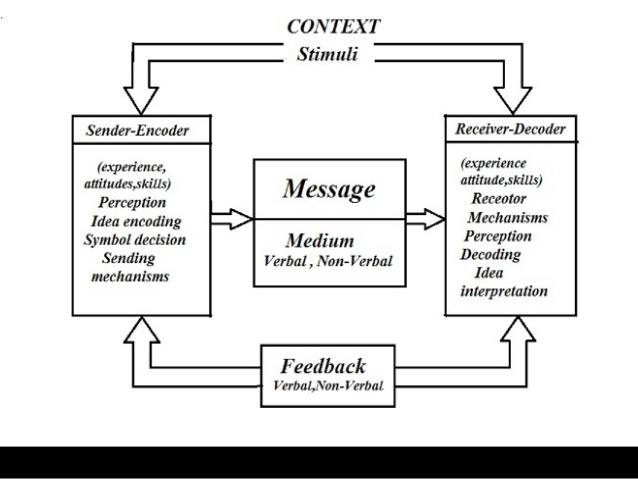Murphy’s Model:
This communication process model is propounded by three writers. According to this model; there are six components of communication process : –
a). Context: – Context is a broad field that includes country, culture, organization, internal & external cause of action and every message weather oral or written begins with context.
b). Sender-Encoder: – The second- encoder used symbols, usually words, to express the message and create desired response.
c). Message: – The message is the core idea the sender wishes to communicate. It consists of both verbal and non-verbal symbols.
d). Medium: – It is the channel through which a message is communicated. It can be printed word, e – mail, sound or gesture.
e). Receiver- decoder: – The receiver/listener is the person who receives the message and decodes it.
f). Feedback: – It can be oral or written. It can be an action such as receiving an ordered item. Sender needs feedback in order to determine the success or failure of the communication.
यह संचार प्रक्रिया मॉडल तीन लेखकों द्वारा प्रस्तावित है इस मॉडल के अनुसार; संचार प्रक्रिया के छह घटक हैं: –
ए)। संदर्भ: – संदर्भ एक व्यापक क्षेत्र है जिसमें देश, संस्कृति, संगठन, आंतरिक और बाहरी कार्रवाई का कारण शामिल है और मौखिक संदेश या हर संदेश को प्रासंगिक संदर्भ से शुरू होता है।
ख)। प्रेषक-एन्कोडर: – संदेश को व्यक्त करने और वांछित प्रतिक्रिया बनाने के लिए दूसरा एन्कोडर उपयोग किए गए प्रतीकों, आमतौर पर शब्द।
सी)। संदेश: – संदेश मुख्य विचार है प्रेषक संवाद करना चाहता है। इसमें मौखिक और गैर मौखिक प्रतीकों दोनों शामिल हैं
घ)। मध्यम: – यह वह चैनल है जिसके द्वारा संदेश संदेश दिया जाता है। यह शब्द, ई-मेल, ध्वनि या इशारा मुद्रित किया जा सकता है।
ई)। रिसीवर-डिकोडर: – रिसीवर / श्रोता एक व्यक्ति है जो संदेश प्राप्त करता है और उसे डीकोड करता है।
च)। प्रतिक्रिया: – यह मौखिक या लिखित हो सकता है। यह एक आदेश हो सकता है जैसे कोई आदेश प्राप्त आइटम प्राप्त करना। संचार की सफलता या विफलता निर्धारित करने के लिए प्रेषक को प्रतिक्रिया की आवश्यकता है
| Theories and Models of Communication | |
| Barriers of Communication, Dec 2007 MCQs | |
| Overcoming Barriers, June and December 2008 MCQs | |
| June 2009 and December 2009 MCQs with Related Current Affairs |
Thill and Bovee Model: –
According to Thill and Bovee communication model, business communication is more than a single act. It is a chain of events consisting of five phases linking sender and receiver.
a). Idea: – The sender has an idea. In the process of conceiving an idea about the real world, the sender leaves out many things but assumes some things. This means idea in the mind of sender is a simplification of the real world.
b). Message: – The idea in the mind of sender is transformed into words and thus becomes a message. The message may be expressed in many ways.
c). Message is transmitted: – The 3rd step in the process is physical transmission of the message through verbal or non-verbal channel, from sender to receiver.
d). Receiver gets Message: – For communication to occur, the receiver has to get the message, and understand the message and store the message mentally.
e). Feedback: – The receiver reacts after receiving the message and sends feedback. Feedback is a key element in the communication process because it enables the sender to evaluate the effectiveness of the message. Then the process is repeated until both parties have finished expressing themselves.
थिल और बोवे मॉडल: –
थिल और बोवे संचार मॉडल के मुताबिक, व्यापार संचार एक एकल अधिनियम से ज्यादा है। यह घटनाओं की एक श्रृंखला है जिसमें प्रेषक और रिसीवर को जोड़ने वाले पांच चरण शामिल हैं।
ए)। आइडिया: – प्रेषक के पास एक विचार है। वास्तविक दुनिया के बारे में विचार करने की प्रक्रिया में, प्रेषक कई चीज़ों को छोड़ देता है लेकिन कुछ चीजें मानता है। इसका अर्थ है प्रेषक के दिमाग में विचार वास्तविक दुनिया का सरलीकरण है।
ख)। संदेश: – प्रेषक के दिमाग में विचार शब्द में तब्दील हो जाता है और इस प्रकार संदेश बन जाता है। संदेश कई मायनों में व्यक्त किया जा सकता है
सी)। संदेश प्रेषित होता है: – प्रक्रिया में तीसरा चरण प्रेषक से रिसीवर तक, मौखिक या गैर-मौखिक चैनल के माध्यम से संदेश का भौतिक प्रसारण होता है।
घ)। प्राप्तकर्ता को संदेश मिलता है: – संचार के लिए, रिसीवर को संदेश प्राप्त करना होगा, और संदेश को समझना होगा और संदेश मानसिक रूप से संग्रहीत करना होगा।
ई)। प्रतिक्रिया: – संदेश प्राप्त करने के बाद रिसीवर प्रतिक्रिया देता है और फीडबैक भेजता है। प्रतिक्रिया संचार प्रक्रिया में एक महत्वपूर्ण तत्व है क्योंकि यह प्रेषक को संदेश की प्रभावशीलता का मूल्यांकन करने में सक्षम बनाता है। तब प्रक्रिया दोहराई जाती है जब तक कि दोनों दलों ने खुद को व्यक्त नहीं किया।








2 responses
Propecia 2mg [url=https://buyciallisonline.com/#]Buy Cialis[/url] Cialis Avis Buy Cialis Renacidin Propecia
Prix Du Cialis 10mg [url=https://buyciallisonline.com/#]Buy Cialis[/url] Amoxicilina In Internet Cialis Canadianpharmacyonline